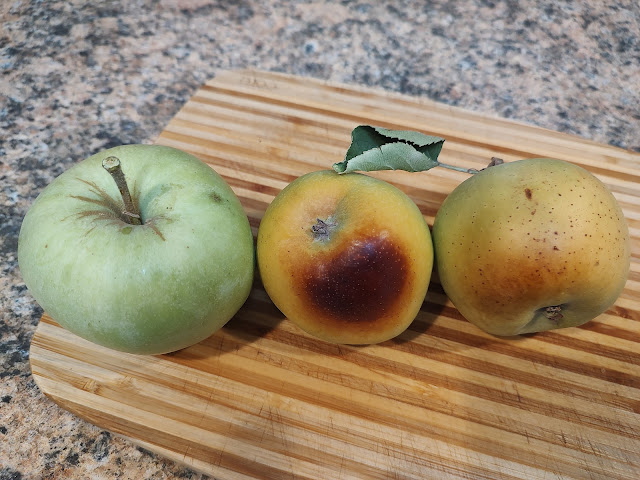
Fruit can develop ugly brown spots even if not exposed to full afternoon sun

|
| These Granny Smith apples are all off the same tree. The apple on the left grew on the north side of the tree. (Photo: Debbie Arrington) |
Another side effect of a red-hot July: Sunburned apples.
Although they need full sun to grow and bear fruit, apple trees can get too much sun -- and absorb too much heat, leading to sunburned apples. Those apples develop dark brown splotches and other scarring.
It’s a problem in Sacramento as well as Washington, the Apple State. No state grows more apples than Washington, which is why that state has devoted a lot of resources researching apple problems.
Sunburn is a major issue for Washington growers, according to Washington State University.
“Growers often lose more than 10% of their apples to sunburn unless they have used some means of protecting their fruit from sunburn damage,” says the university’s Crop Protection Guide. “Apple fruit are susceptible to sunburn because they have a much higher thermal mass (the ability of a material to absorb and store heat energy) than leaves and are not able to dissipate this heat as effectively as leaves.”
The apples hanging on the tree can absorb more heat than their tree’s leaves. In fact, fruit temperature can be 20 to 30 degrees higher than the surrounding air temperature, say the researchers. It’s that high heat – and not necessarily direct sun – that can cause sunburn.
Those brown splotches – called sunburn browning – are caused by a combination of the sun’s UV rays and high temperatures. They appear when the fruit surface temperature has reached 115 to 120 degrees F. Fruit nearing harvest is most susceptible.
If the fruit temperature tops 125 degrees – even for only 10 minutes – cells start to die in the fruit, resulting in sunburn necrosis. That results in black or dark brown lesions, regardless if the fruit was exposed to direct sunlight. “This type of sunburn can be exacerbated by low humidity,” say the WSU researchers.
Sunburned apples are edible; the damage is mostly cosmetic and can be trimmed off. But WSU researchers found sunburn also changed the apple’s chemistry and taste. Sunburned apples tend to be firmer, have a higher sugar content and less acid. They may taste a little sweeter, but the lack of acidity also made them taste bland – not a good characteristic, especially for pie apples.
WSU recommended providing a little filtered shade to apple trees that tended to produce sunburned fruit, especially on their south- and/or west-facing sides. That shade could be as simple as protective netting.
“Protective netting may be deployed above the orchard canopy or draped directly over apple trees and has proven to be effective at reducing sunburn incidence, as well as conferring other benefits such as protecting against hail damage, reducing wind stress, and potentially excluding some invasive insect pests and birds,” say the researchers.
To protect against sunburn, Washington growers depend on “evaporative cooling” – basically, misting trees with extra water to cool them down. It’s expensive – and impractical for backyard apple growers.
And yes, there is sunscreen for apples. Growers may spray products that put a thin coat of clay particles, calcium carbonate or UV-blocking wax over the fruit. But those products tend to leave a residue film over apples that can be hard to wash off.
For more on apples and sunburn: http://cpg.treefruit.wsu.edu/environmental-fruit-protectants/apple-sunburn/ .
And for how to protect trees and shrubs from sunburn: http://ipm.ucanr.edu/PMG/GARDEN/ENVIRON/sunburn.html .
Comments
0 comments have been posted.Sacramento Digs Gardening to your inbox.
Sites We Like
Garden Checklist for week of July 21
Your garden needs you!
* Keep your vegetable garden watered, mulched and weeded. Water before 8 a.m. to reduce the chance of fungal infection and to conserve moisture.
* Feed vegetable plants bone meal, rock phosphate or other fertilizers high in phosphate to stimulate more blooms and fruiting. (But wait until daily high temperatures drop out of the 100s.)
* Don’t let tomatoes wilt or dry out completely. Give tomatoes a deep watering two to three times a week.
* Harvest vegetables promptly to encourage plants to produce more. Squash especially tends to grow rapidly in hot weather. Keep an eye on zucchini.
* Pinch back chrysanthemums for bushy plants and more flowers in September.
* Remove spent flowers from roses, daylilies and other bloomers as they finish flowering.
* Pinch off blooms from basil so the plant will grow more leaves.
* Cut back lavender after flowering to promote a second bloom.
* It's not too late to add a splash of color. Plant petunias, snapdragons, zinnias and marigolds.
* From seed, plant corn, pumpkins, radishes, winter squash and sunflowers.